
How Semi-Trucks Are Crash Tested
Every year, there are half a million semi-truck accidents in the US. Alone. That’s why, just like passenger cars, these massive vehicles need to be crash tested to ensure they are safe for public roads.
Swedish Cab Strength Test
Besides the typical crashed impact trials every car undergoes, there are a number of tests specifically made for semi-trucks. Although not required by international regulations, Volvo trucks and Volkswagen Scania are famous for performing what’s called the Swedish Cab Strength test.
Designed to simulate the damage impacted by a rollover crash, this test is meant to see if the cab will remain intact under high pressure. First, the roof is evenly loaded with a 15-ton weight.
Next, a 1.4-ton pendulum barrel is swung full speed into the CAB’s front pillar the weakest part of the cab. Finally, a second pendulum barrel is launched into the CAB’s rear wall. In order to pass the test, the resulting damage must not breach the driver’s survival space.
The cab has to retain its original structure without any big holes or protruding sharp edges. The test is frequently described as the industry’s most difficult. But as much as companies like Volvo and Scania brag about passing it, their engineers don’t stop there. And their cabs are still subjected to plenty of actual high-speed rollover tests.
Trailer Testing
But trucks need more than their cabs tested. The tractor-trailers they carry are equally important. But it’s not about protecting the trailers. These tests are for protecting passenger vehicles. In 2019 over 850 us.
Drivers died in crashes with the rear or side of a semi-truck. 80% of them involved some kind of underwriting where a car ends up under the semi or its trailer. Stats like these are why the Insurance Institute for Highway Safety tests the use of underwriting guards.
These are metal bumpers that hang down off the back and sides of the trailer. Tests involve sending bid-sized cars at 35 mph into these guards to test their durability and the damage they prevent the passenger dummies.
Unfortunately, these tests aren’t required for trailers to pass safety standards. And while side underwriting guards on trucks have been required by the European Union since 2003, they aren’t mandatory on U.S. Roads. Still, the most extensive crash testing remains. Impact trials are familiar to anyone who’s ever seen a crash test.
Video impact tests help trucking companies analyze just how safe their cabs will be for drivers in a crash. Crash impact tests take on a number of forms. This includes offset barrier tests meant to simulate crashing into the back of a truck, and head-on collision tests.
In each test, these 8-12 ton trucks are crashed at speeds of 30 to 50 mph. Researchers and engineers evaluate the damage to the test dummies, which are designed to resemble actual human bodies, as accurately as possible.
They take thorough notes on which parts of the dummies receive the most damage. This information helps researchers develop improvements to prevent that type of injury in future crashes. They also evaluate the damage to the cab itself. This includes structures like its frame and electronic systems.
Electric Vehicle Testing
Semi-truck crash testing hasn’t stopped evolving though. Just like EVs are expected to become the standard for the car industry within the next few decades. The same is true for semi-trucks. Scania already launched its first electric truck last year.
However, while a regular road car chassis can package battery packs inside the wheelbase, the cab of a semi can’t sacrifice any passenger or powertrain space to keep the batteries inside the frame. Instead, the cells go into boxes on the side which replace the fuel tanks.
Because of this design, these external battery packs and the protective plastic casing around them need to be crash-tested. For durability, Scania uses a head-on impact from Volkswagen’s Golf compact car travelling at 35.
The desired result is that the energy from the impact is distributed throughout the structure surrounding the battery. The company hasn’t released full data about the test but says it went as expected and the batteries emerge unscathed. There are reasons companies like Volvo, Scania and IIHS take truck crash testing so seriously.
Every year about 5000 people are killed in crashes involving semi-trucks. In the US. Alone in 2019, 67% were passenger car occupants. It’s the research gained from crash tests that help make trucks safer for those behind the wheel and the everyday drivers on the roads beside them.
Conclusion
Truck safety and testing are ever-improving with the introduction and advancements in electric vehicles, ensuring these new trucks will be safe for public roads and help reduce the number of casualties.
Thanks to trucking companies like Volvo and Scania as well as the Insurance Institute for Highway Safety, safety standards for these trucks are only improving.



